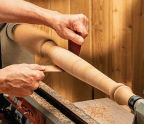
You use your table saw routinely for ripping and crosscutting wood in perfectly straight lines, guided by the fence or miter gauge. Tilt the blade or adjust the gauge, and you get straight bevels or mitered cuts.
No argument, that’s the table saw’s bread and butter. But beyond those basic techniques are several others you should consider adding to your arsenal of skills. Let’s take a look at three of the most useful ways to go beyond the basics.
Cove Cutting
Coves are common in molding, trim, picture frames, box components and more. Small coves, like simple coved trim, are easy to make with a router. But for wider, deeper coves for crown molding, box sides and other larger projects, you need either a shaper with large-scale cutters or a well-stocked trim supplier.
But you can also cut coves on your table saw. The process may seem tricky (and maybe a bit scary if you’ve never done it before), but it’s really just a matter of simple preparatory steps and the right guidance for your workpiece. The type of blade you use doesn’t matter, but a higher tooth count produces a smoother cut.

While coves are arcs, you still cut them in a straight line. The




